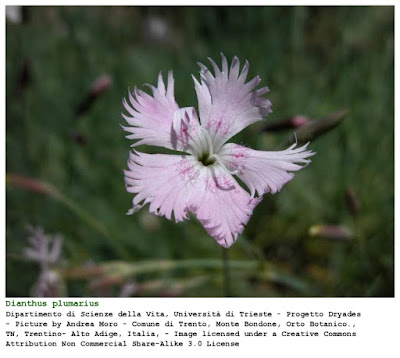Modern pinks, such as D. Herbetii and D. Allwoodii groups, have other blood in them, showing traces of perpetual border carnation ancestry.
The rarest of the native British Dianthus is the annual Deptford Pink, Dianthus Armeria. Once widespread around the Cheddar Gorge, the strongly-perfumed flowers of Dianthus Gratianopolitanus (previously known as Dianthus Caesius)were so popular with nineteenth-century gardeners that it was collected to near extinction. The most commonly-grown of the native species, Dianthus Deltoides, now only found in part of East Anglia, has creeping-dark green stems and small crimson-red flowers.
Some early authorities including John Claudious Loudon (1784-1843) considered the pink to have been bred from various historical parents including Dianthus Carsius and varieties of carnation rather than just being an improved cultivar of Dianthus Pulmarius.
Thomas Mawe in Every Man his own Gardener (1792) lists eleven pinks: Dobson, Deptford, Cob White, Cob Red, White Shock, Damask, Mountain, Matter, Old Man's Head, Painted Ladyand Clove Pink.
Older pinks may be dived into two classes:
1. Flowers of the "Delmonden Fairy" type, with stout, close and upright foliage with thicker flower stems and finer flowers resembling a little border carnations, possibly from an ancient natural cross and,
2. Those with small, dense foliage matted on the ground. Flowers being on thin erect, short stems like the old Pheasant Eye.
Pheasant-Eyed Pinks were referenced in the early 18th Century by writers on gardening but date back to the 17th Century and beyond. The centre of the flower is deep red and the fringed white petals have a red stain to their tips. The perfume is softer than other pinks.
Allwoods Heritage Garden Pinks - Pheasant Eye (Pre 1600's)
Plain Pinks and Laced Pinks were developed by muslin weavers from Paisley. Known as Scotch Pinks because of the Paisley cultivation, this name became attached to those varieties without lacing, "black and white". Dianthus Dad’s Favourite is thought to be one of the few surviving Paisley Pinks with white petals edged with a broad ruby-red line.
Laced Pinks with white ground were divided into dark-laced and fine-laced according to the depth of colour in their markings.
Rose Pinks are those where the ground colour was rose and the petals marked and laced with a darker shade.
Anne Boleyn is a Rose Pink and featured in the Florists' Magazine, 1835 - 36.
Jane Loudon - Artist's Biography
Dianthus plumarius. Sir Walter Scott, Duke of St. Albans, Anne Boleyn. Pl. 24. Lithograph handcolored, c.1840.
Dianthus Superbus pictured in the top left hand side of the picture below has a stonger, spicier perfume than Dianthus Plumarius with white spidery flowers that John Parkinson, the 17th-century gardener, described as "comforting the spirits and the senses".
The early 19th Century was the hey day of the pink. In The Flower Garden 91839) M'Intosh, the gardener to the King of the Belgians listed 192 varieties. Thomas Hogg, a nurseryman from Paddington London listed 121 varieties in his catalogue of pinks in 1822.
Most of the laced or scotch pinks from this period appear to have disappeared apart from Dad's Favourite. A number of the ordinary pinks from this time are still around such as Paddington, a rose-pink seated edged flower zoned with purple, the Earl of Essex, Inchmery, Painted Lady, Dark Eyes Susan and Fimbriata, Sutton Pink and Ledford Pink.
Few varieties were introduced between 1850 and just after the end of the first world war when Mr. C. H. Herbert started to raising pinks apart from Mrs. Sinkins and Her Majesty. Herbert pinks were developed using a number of old pinks. His outstanding variety is perhaps Bridesmaid.
After the Second World War the Lindabruce Nurseries crossed Herbert's varieties with Dianthus Allwoodii resulting in the Lancing pinks.
At the same time, Mr. F. R. McQuown in London was using D. Allwoodii and Herbert's pinks together with old laced pinks to raise the London pinks.
Allwoodii pinks were raised by Mr. Montagu. C. Allowed who after the First World War stared crossing perpetual-flowering carnations with the old fringed pinks, who were used as the seed-bearing parents. The resulting hybrid strain was named Dianthus Allwoodii. Scent was sacrificed for flower production, though Allwood’s best-known plant, Dianthus Doris does have a slight scent.











No comments:
Post a Comment